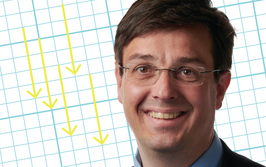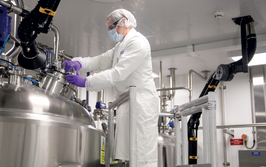Michael May

CEO and President, Centre for Commercialization of Regenerative Medicine
Having founded the Centre for Commercialization of Regenerative Medicine (CCRM) more than 10 years ago, Michael May has helped create a world-class organization with more than 200 employees (and over 700 alumni), as well as a center of excellence for innovation in cell and gene therapy manufacturing. CCRM is now a destination for international therapy developers to create sustainable manufacturing processes. May’s success in Canada has led to the implementation of similar CCRM franchises in Australia and Sweden, worldwide collaborations with leading cell and gene therapy technology providers, and the creation of CDMO OmniaBio. Under May's guidance, CCRM has flourished to become an important voice for building effective and sustainable commercialization capabilities.
What is the biggest challenge facing the field right now?
There are still many challenges in the field, but the most pressing is dealing with how we drive scale and adoption. On top of the often cited challenges of enabling large scale, robust and cost effective manufacturing, the industry needs to scale access to capital (particularly at the early phases) and development of the specialized talent needed to tackle the complexity of “living therapies”. Achieving a “tipping point” in the industry will ultimately be catalyzed by developing a fit-for-purpose strategy that enables adoption of these unique products focused on the patient journey, clinical delivery, manufacturing, and reimbursement.
Tell me about a mentor or educator who has inspired you.
I grew up in Brantford, Ontario, a smallish city in Canada, near Toronto. This was the place Alexander Graham Bell emigrated to when he was 12 years old, and the place he conceived many of his inventions, including the telephone. Indeed, the first long distance telephone call was issued from Brantford to a town eight miles away. As a child, I was fascinated and inspired by the inventiveness of Graham Bell – from the telephone to flight to hydrofoils and teaching those with hearing loss. It is also amazing that 40 minutes north, on the same river that runs through Brantford, is the place where the smartphone (Blackberry) was invented.
In the 1960s, Marshall McLuhan, a University of Toronto Professor became a public celebrity for his work on technology, telecommunications, and the new media. He philosophized on the impact of TV on the human condition, coining such phrases as “the global village” and the “medium is the message”. The latter concept described one of his main theses – that what was shown on TV was not as important as the fact that TV (the medium) catalyzed human connectivity, collaboration, and experience beyond what radio or the printed word can do. McLuhan’s work foreshadowed the internet, smartphones, and social media. This inspired me in my work at CCRM where our focus is on ecosystem building in support of commercialization. Like “the medium is the message”, I believe that “the ecosystem is the product”. That is, it doesn’t matter the specific technology or company we are working on, what matters is that we are building an ecosystem. If we engineer the ecosystem, everything else falls into place.
For me, ecosystem is synonymous with network. My PhD thesis supervisor and mentor, Michael Sefton, helped me understand the power and ubiquity of networks in our world and the importance of leveraging social connectivity in leadership and ecosystem building.
Graham Bell and the telephone, McCluhan and media, Sefton and leadership – the common theme is that the world operates through a series of interacting biological, social, and physical networks. I have become a network engineer.
How can we attract more talented scientists to the field?
To answer this question, I think that we all need to reflect on what attracted all of us in the sector to science. For me, it was an evolution from raw awe in the world to a sense of wonder and curiosity. After that, it was an easy step to want to understand, leverage, and then engineer science as a career. We need to capture kids at those early stages of wonder and awe, and make them realize the science behind the TV they watch, the smartphone they obsess over, and the athletes they adore. We need to enthusiastically explain that every heartbeat is connected to millions of layers of networked biology and chemistry in their body, and that each breath connects them to every other plant and animal on the planet. Considering all the crackpot things people believe in now and in the past, communicating science more effectively should produce results. After all, we have a method in our corner that favors data, truth, and a never-ending skepticism of our work.
What is your most controversial opinion about the field?
Cell and gene therapy represents the future of medicine. It is complex, amazing and transformative. Indeed, It may end up being the greatest example in history of human cooperation and collaboration, once the promise of cures is finally achieved and delivered on a large scale. I sometimes get frustrated, however, when we talk about the industry as completely breaking new ground, without fully leveraging other sectors or the lessons of history. For example, we debate about autologous versus allogeneic, or centralized versus decentralized manufacturing. But when a patient is diagnosed and treated with heart disease today, there are options. In the most severe case, a patient might need a heart transplant, which requires a donor and specialized personnel (surgeon plus team) and infrastructure (advanced equipment in an operating theater) for this life-saving intervention.
In other cases, we might take tissue from the patient’s own body (a vein from the lower leg) to reconstruct the vessels feeding the heart. This procedure is less risky than a heart transplant, but still requires surgeons and operating rooms. More and more often, complex stents manufactured in a centralized facility are transported to hospital facilities to be inserted in short, routine procedures by physicians. These stents are not manufactured at the bedside, but in professional, well-controlled facilities.
Most heart patients are treated with chemical drugs that are dispersed through a pharmacy, taken with a glass of water, and manufactured in centralized, regulated facilities at large scale through optimized workflows. Cell and gene therapy will be the same. We can imagine how the specialists, infrastructure, pharmacies, and manufacturing for cell and gene therapy might look in the future, but it won’t look much different than the above.
Make a comparison of your work to a classic movie
Two classic movies from the 80s that represent the challenge of our industry and resonate with my role at CCRM are The Breakfast Club and Dead Poets Society. The Breakfast Club is a coming-of-age film that follows five high school students from different social cliques who are forced to spend Saturday detention together. As they bond and open up to each other, they discover common ground and form unexpected connections, illustrating how shared experiences can bridge gaps and foster community.
In Dead Poet’s Society, an unconventional English teacher inspires his students to seize the day and pursue their passions. Through his teachings, the students form a tight-knit community and challenge the school’s rigid, boarding school traditions, emphasizing the importance of individual expression and collective empowerment.
What goals would you still like to personally achieve?
CCRM is based in Canada, a small market country advancing great science that is supported by excellent clinical infrastructure, treating patients through a single-payor healthcare system. To unlock sufficient resources (IP, funding, and capabilities) and tackle a complex global market, I feel the model needs to be scaled. In true Canadian style, my goal is to share the model globally and then craft a collaborative framework for a network of “CCRM hubs”, generating local economic and health benefits while realizing global synergies. This is a professional goal.
On the personal side, I would like to see our planet from space – the entirety of Earth’s biological and social networks all in one view. I wanted to be an astronaut when I was young.
Make a prediction for the far flung future of the industry that may seem like science fiction but could one day be a reality
Nobody does toilets like the Japanese. My prediction is that we will expand on the Japanese concept of a toilet and make our morning duty a pillar of individualized healthcare. The toilet of the future will analyze the composition of our urine and feces, of course, but also a slew of other parameters through transdermal biosensors (maybe a slight skin prick in the early generations) and combine this data with measurements of blood pressure, weight, EKGs, temperature, respiration, and weight (and who knows what else?) to generate a daily health score that will be analyzed by AI and your physician.
The toilet will then tell you what yogurt, filled with genetically engineered bacteria, to buy at the grocery store (probably delivered automatically by a future version of Amazon) to supplement a menu for the day and a suggested exercise regimen. It may recommend treatments, including prophylactic interventions, but will also detect serious illnesses or chronic disease, building the dataset required for personalized, advanced cell and gene medicines. Imagine all of that before coffee!


















